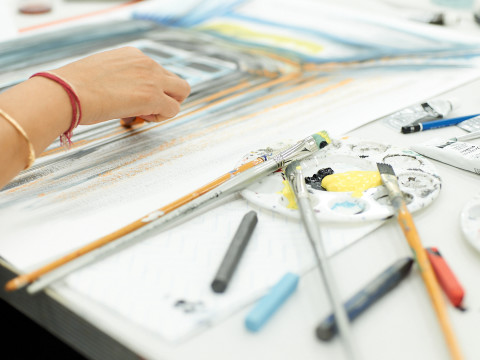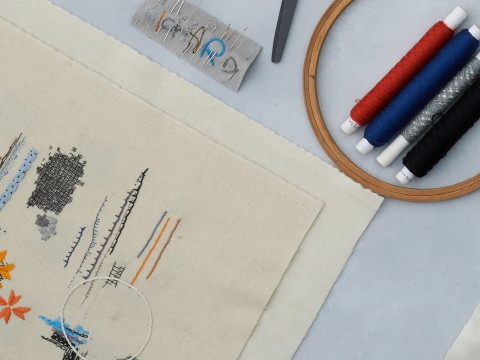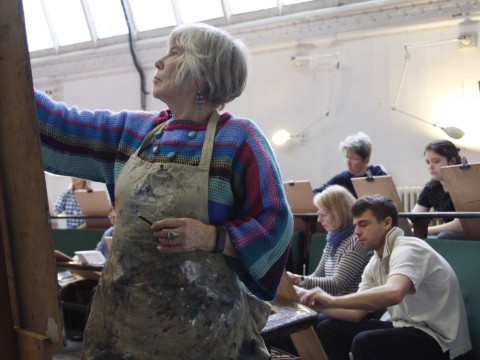
Art and anatomy: the fabric of the human body
Six-week art history and theory course
13 May 2019 6.30 - 8pm20 May 2019 6.30 - 8pm27 May 2019 6.30 - 8pm3 June 2019 6.30 - 8pm10 June 2019 6.30 - 8pm17 June 2019 6.30 - 8pm
The Life Room, Royal Academy Schools
£420. Includes all materials, light refreshments and a wine reception at the end of the final session.
Terms and conditions
Join a group of artists, curators and medical specialists to explore the art of human anatomy through the ages in a theory course inspired by the Royal Academy’s long-standing relationship with the study of anatomy.
For millennia, the human body has been observed, copied, examined and opened up, in an attempt to provide answers to the fundamental questions posed by scientists and artists alike: who are we and what are we made of? This unique course offers the opportunity to learn about the history of the importance of the study of anatomy for artists and anatomical art from key international scholars and artists.
Although dissection was largely forbidden in the ancient world, this did not stop great thinkers of the period such as Galen and Vitruvius from examining the mechanics and proportions of the body, and their theories dominated Western thinking for centuries to come. Participants will explore the early anatomical theories of the Renaissance, when an increasing number of artists and anatomists influenced each other to explore the science of the body. Scholars at this time were not only revitalising classical ideas of the body, but were also challenging them: the 16th century physician Vesalius published his influential treatise De humani corporis fabrica, a rare edition of which is now in the Royal Academy’s collection.
The body-snatching of nineteenth-century Britain, the cadaver dissections by William Hunter and the Royal Academy’s own grisly history with écorché figures – plaster casts of real, flayed human bodies – all suggest artists' enduring fascination with the flesh and the body itself.
As well as being educational aids, the manuscripts, drawings and sculptures produced during the search for understanding are works of art in their own right, housed in museums, galleries and private collections all over the world. The complicated history and provenance of such objects raises difficult and fascinating questions about how to display and curate such works in both educational and aesthetic contexts, which are explored in this course by anatomical experts and leading curators.
Through a series of lectures, debates and case studies, participants discover the history of anatomical art; explore how artists have always worked innovatively at the intersection of art and science; and explore ways of thinking about the relationships between mind and body.
This course takes place in the RA Schools' inspirational Life Room which is home to key works from the RA’s cast collection and the historic setting for the teaching of life drawing for generations of Royal Academy artists and students.
This unique course is designed to complement the practical art course: Beyond Skin Deep: Anatomical Drawing and Painting. Sign up for both courses for the special price of £800 (discount offered at check-out).
£420. Includes all materials, light refreshments and a wine reception at the end of the final session.
The Anatomy Professor
Terms and conditions
Jack Hartnell
Lecturer in Art History
University of East Anglia
Dr Jack Hartnell is Lecturer in Art History at the University of East Anglia, Norwich, where his research and teaching focuses on the visual culture of late medieval medicine, cartography, and mathematics. Before starting at UEA he held a series of fellowships at Columbia University, The Courtauld Institute of Art, and the Max-Planck-Institut in Berlin. His latest book is Medieval Bodies: Life, Death, and Art in the Middle Ages, published by the Welcome Collection in London.
Annette Wickham
Curator of Works on Paper
Royal Academy Collections
Annette has curated numerous exhibitions and Collections displays at the Academy including John Gibson RA: A British Sculptor in Rome, Daniel Maclise: The Waterloo Cartoon, and Drawing: The Lines of Time with Ann Christopher RA.
She regularly publishes and gives talks on various aspects of the history of the Royal Academy, its Collections and its Schools. She also contributed the introductory essay for Artists Working From Life, to accompany the From Life exhibition, and chapters on anatomy and drawing for a book about the Academy and its Collections due to be published in Spring 2018.
Annette studied History of Art at Manchester University and the Courtauld Institute and was previously an Assistant Curator at the Victoria and Albert Museum.
Simon Chaplin
Director of Culture & Society
Wellcome Trust
Simon Chaplin is a curator and public historian, specialising in the history of anatomical museums. He is currently Director of Culture & Society for the Wellcome Trust, where he leads programmes for humanities & social science research, public engagement, education and international cultural projects. He is also the Director of Wellcome Collection, a free museum and library which seeks to challenge how we think and feel about health. He was formerly Head of the Wellcome Library, and Director of Museums & Special Collections at the Royal College of Surgeons.
Eleanor Crook
Artist
Eleanor Crook is a sculptor in wax, bronze, and lifelike media who makes work about anatomy and mortality. She studied Classics and ancient art history which instilled a fascination for statues, effigies and mummies which she found was better explored by making them. Whilst studying sculpture at Central St Martins and the Royal Academy Schools she learned anatomy from medical museums and sculpting from Victorian textbooks, adopting neglected figuration techniques. Later she trained as a medical sculptor alongside medical students at Guy’s Hospital. She is artist in residence at the Gordon Museum, tutor at Ruskin and Camberwell, and works internationally with medical museums such as the Vrolik, Amsterdam, La Specola, Florence and the Pathology Museum of Florence University. She has a special interest in learning the expressive techniques of former times whilst employing contemporary technology such as animatronics, special effects and forensic facial reconstruction to bring her creatures to a kind of life.
Stephen Farthing RA
Painter and writer
Stephen Farthing is a British painter and writer. He was elected to the Royal Academy of Arts in London in 1998 and currently serves as the Chairman of its Exhibitions Committee. Farthing has exhibited extensively in solo shows since his first solo exhibition held at the Royal College of Art Gallery, London. His work, representing Britain, was shown at the Sao Paulo Biennale, leading to many further solo shows around the world – including in the UK, US, Mexico, Argentina, Uruguay, Japan, Australia, New Zealand, and France. Farthing has been commissioned to create paintings for the National Portrait Gallery, London, the Cleveland Browns, and the Dorset Hospital Trust, among others. His most recent publication that he wrote with his brother Dr Michael Farthing MD , Leonardo da Vinci: under the skin was published by the RA in January 2019. Farthing studied at St Martin’s School of Art, London, completed a master’s degree in Painting at the Royal College of Art, London, and won a post-graduate painting scholarship at The British School at Rome. His extensive teaching career includes acting as a Tutor in painting at the Royal College of Art, London, a serving for a decade at the University of Oxford as a Professorial Fellow and the Head of the Ruskin School of Fine Art, and working as the Executive Director of The New York Academy of Art in Manhattan. He was also the Rootstein Hopkins Research Professor of Drawing at the University of the Arts London from 2004-2017.
About the course
This course provides a unique opportunity to learn about the history and theory of anatomical study in science and art and explores the genre across ages and cultures, led by expert guest speakers.
This course will be delivered through lectures, but will also include an opportunity for questions and discussion from participants.
The course is designed to provide an historical overview for those new to the field, while being relevant for those with prior knowledge keen to learn more from experts in the field.
This course is suitable for enthusiastic beginners as well as those with previous knowledge who would like to develop their understanding further.
This course is for you if:
• You have a general interest in art history and would like a novel way to understand cultural and historical changes in art
• You have a general interest in science, biology and anatomy and would like to explore this subject through art history and theory
• You have a personal or professional interest in how the study of anatomy has been presented, interpreted and viewed by different audiences and in different historic periods
• You would like to deepen and enrich your knowledge with an expert perspective and explore in detail the development of anatomy
Minimum age 18
£420
Monday 13 May – Monday 17 June 2019
6.30pm-8pm each session
This course provides:
• 6 expert-led lectures with the opportunity for questions and discussions
• The opportunity to learn and reflect within a peer group and engage in expert-led discussion
• The opportunity to socialise and network with peers in a friendly environment
• A drinks reception at the end of the final week
• A certificate of participation upon course completion

Beyond skin deep: anatomical drawing and painting
With each of the six classes taught by a different artist and expert tutor, this practical course provides a remarkable way to develop your drawing skills as well as exploring representation of the human body.
A unique course designed to complement this art theory course. Sign up for both courses for the special price of £800 (discount offered at check-out).

About the space
The Life Room
The Royal Academy’s historic Life Room sits at the heart of the RA Schools. Usually closed to the public, this unique and significant space was designed in the 1860s, when the galleries and art school first moved to Burlington Gardens.
The semi-circular seating arrangement, based on an ancient design, traces its British history back to Hogarth’s Academy in St Martin’s Lane, c.1730. Directional light is used to enhance the delineation of the model’s musculature and aid life drawing, which has been practised in this room by generations of Royal Academy artists and students.

Our courses and classes programme
Our programme of short courses and classes offers the opportunity to explore a range of subjects, led by expert tutors and practising artists.

Give this course as a gift
All of our courses can be purchased as a gift for a friend or family member – giving the gift of education and a remarkable experience. To arrange a personalised Gift Voucher, please contact Anna Pojer, Academic Programmes Manager, by calling 020 7300 5684 or email anna.pojer@royalacademy.org.uk
Related events
 Short courseFree
Short courseFreeThe Primary Art School
9 January - 12 June 2025
 Short course
Short courseBotanical art
11 March - 8 April 2025
 Short course
Short courseExploring ink: method and imagination
29 March - 30 March 2025
 Short course
Short courseDepicting the figure: Renaissance to Modernism
29 April - 27 May 2025
 Short course
Short courseRevolutionaries and Romantics: art and literature in France
17 May - 18 May 2025
 Short course
Short courseOil painting: techniques and discovery
17 May - 18 May 2025
 Short course
Short courseSketch with stitch
21 June - 22 June 2025
 Short course
Short courseConnoisseurship summer school: who painted what, when and how to tell
1 July - 5 July 2025
 Short course
Short courseLife drawing summer school
8 July - 12 July 2025
 Short course
Short courseDrawing with anatomy
15 July - 19 July 2025
 Short course
Short courseExpressive life drawing: observation and imagination
15 July - 19 July 2025
 Short course
Short courseLandscapes: van Gogh and his influence
2 September - 6 September 2025